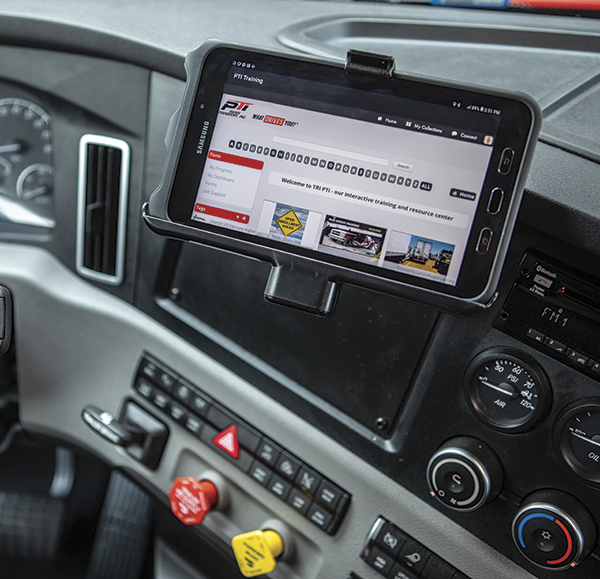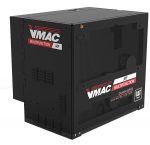As industries across sectors look ahead to the next decade, they are grappling with new technologies and the challenges and opportunities they bring. Advances in 5G, augmented reality, and artificial intelligence are disrupting familiar business models, promising new efficiencies and revolutionizing the way companies operate. The fleet trucking industry is no exception.
For over forty years, trucks have been this country’s leading method of transporting goods from place to place—easily eclipsing railways, air travel, and all other forms of transportation, according to the Bureau of Transportation Statistics. Technology won’t replace humans in our industry—a computer can’t perform vehicle maintenance by itself, talk to a manager at a distribution center, or lead onboarding training. However, a new wave of digital innovations in technology can make the work of our truck drivers easier, safer, and more efficient.
Today the fleet trucking industry is wrestling with three central, intersecting challenges: navigating government regulation, training and retaining skilled drivers, and ensuring the highest possible safety standards. In all of these areas, innovations in digital technology have had an impact, enabling transportation companies to use mobility to gain a powerful advantage.
For fleet-management organizations considering where it makes the most sense to deploy technology for benefit, here are three areas that are pioneering the trucking industry’s adoption of new technologies:
NAVIGATING REGULATION
For years most truckers relied on automatic onboard recording devices (AOBRDs): a piece of equipment that connects directly to a vehicle’s engine to monitor a driver’s hours. However a few years ago, the Department of Transportation introduced a new mandate that required truckers to switch from AOBRDs to newer electronic logging devices (ELDs).
This change, while well-intentioned, can be cumbersome for truckers and carriers to implement. ELDs can carry a high price point, and learning how to use the technology properly can be difficult for truckers who are used to preceding systems.
To ease this transition, technology leaders like Samsung have worked hard to develop purpose-built tablets that are quick to install, easy to use, and cost-efficient for carriers. These devices combine the best of both worlds: They’re easy to use, just like older AOBRDs, and they have all the functionality of newer ELDs and more. And drivers not only have a device that is built for high performance while on the job, but the ELD device also serves as a personal tablet that provides access to a driver’s favorite content, such as movies, books, and music, for downtime while on the road. Moreover, these devices aren’t just purpose-built for how truckers work, they’re built for the future with models that are durable on the road.
Additionally, the federal government has already introduced another new rule requiring a more specific type of training for new drivers. With these tablets in the hands of drivers across the country, delivering training on new compliance updates will be easier and less expensive, available on a device built tough for the trucker’s cab environment.
TRAINING & RETENTION
With each passing year, truck drivers retire and new ones take their place at a time when new regulations make training and onboarding more challenging than ever. Against that backdrop, training and retaining skilled drivers has never been more important.
Connected devices are the perfect tools for the fleet trucking industry to provide training and support. Through these devices, companies can provide their employees with comprehensive training modules and support systems—even when they’re working remotely from the road.
In 2015, Samsung began its partnership with Wisconsin-based trucking company Paper Transport. At the time, the company had significant concerns about training and retention. As one of its leaders said, “We had drivers on orientation day that would look at the system we were using and walk out because of how complicated and antiquated it was.” Paper Transport knew that without the best drivers, the company would face challenges.
Over the course of the next several months, it replaced its old equipment with ruggedized Samsung tablets, which integrate software providing world-class training modules to monitor driver performance and allow employees to access HR benefits and updates—all from a single device. With defense-grade security driven by the Samsung Knox platform, its IT department could easily configure and update these tablets remotely and manage its entire fleet at once.
Samsung’s recent case study on the partnership proved astounding results.Driver engagement increased nearly fourfold with drivers starting to watch training videos voluntarily instead of being required to do so. And with comprehensive, on-the-road support, drivers had less incentive to seek jobs elsewhere; according to the company, since implementing Samsung’s ruggedized tablets, Paper Transport reduced its turnover rate nearly 10%.
SAFETY
Of course even for the most experienced drivers and tested fleets, safety is a constant concern. While regulation on the trucking industry grows, accident rates have yet to decline. Thankfully, new technologies such as artificial intelligence (AI) and augmented reality (AR) are giving us new ways to keep drivers safe.
We all know that truck drivers shouldn’t use their phones while on the road. But we also know that driving can be taxing. That’s why we need purpose-built devices that are smart enough to know when it’s safe for drivers to use them. Samsung tablets are built with accelerometers and gyro sensors, so they can tell when the vehicle is in motion and when it’s not. That means managers can customize devices to lock functions such as phone calls and web browsing while a driver is moving—so drivers can keep their focus on the road while they’re driving and call their family or play games when they stop for a break.
Of course, not all accidents are a result of human error, and driving a truck includes the task of ensuring your vehicle is always in working shape. Thanks to AI and AR, diagnosing and repairing a problem with a vehicle is easier than ever.
For instance, with augmented reality platforms like Librestream’s Onsight, a driver can pull over to the side of the road, point their device’s camera at the chassis, and pull up step-by-step instructions on how to fix what’s gone wrong. If additional input is needed, the driver can quickly bring in remote experts to diagnose the issue immediately. The data captured in the field is automatically stored and used for AI-based machine learning.
NEW-ERA TRUCKING
The applications of these new technologies—from safety to training to navigating regulation—are transformative. In a 5G-powered world for example, autonomous vehicles can take over for a tired trucker during long stretches of open road. AI can calculate the most efficient route by monitoring traffic across a city. And truckers can access digital instruction manuals in AR and fix their vehicles when something goes wrong.
This new era is not far off. Some of these advances are in use today for fleet management. Others are already here. For over four decades, trucking has been the backbone of American commerce. If the leaders of the fleet trucking industry embrace these new technologies, it can continue to be for many more decades to come.
ABOUT THE AUTHOR
David Solomonraj is the director of business development, transportation, and logistics at Samsung. Find out more about Samsung for fleets, visit
www.samsung.com/us/business/solutions/industries/transportation/.
_______________________________________________
MODERN WORKTRUCK SOLUTIONS:
JANUARY 2020 ISSUE
Did you enjoy this article?
Subscribe to the FREE Digital Edition of Modern WorkTruck Solutions magazine.




